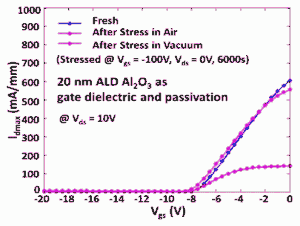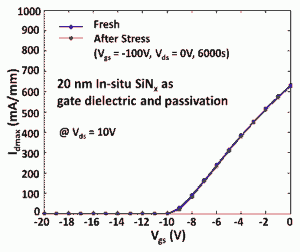Use of in-situ SiNx to Reduce the OFF-state Degradation of AlGaN/GaN HEMTs
- Category: Electronic Devices
- Tags: carl thompson, feng gao, gallium nitride, tomas palacios
Thanks to their excellent electrical performance, AlGaN/GaN high electron mobility transistors (HEMTs) are considered ideal devices for the next generation of high-power and high-frequency electronics [1] . However, the limited understanding of their long-term reliability and degradation mechanisms is slowing down the insertion of these devices in actual systems [2] .
Recently, we have reported the formation of oxide particles next to the gate edge of GaN HEMTs after OFF-state step-stress degradation experiments [3] . Underneath these particles, pits similar to the ones reported in previous papers [4] are observed. In this work, we investigate the role of oxygen in the formation of these particles/pits during OFF-state stress and use oxygen diffusion barriers to improve the reliability of AlGaN/GaN HEMTs.
Two different dielectrics have been used: Al2O3 deposited by atomic layer deposition and in-situ SiNx deposited immediately after the growth of the AlGaN/GaN epitaxial layer by metal organic chemical vapor deposition (MOCVD). Step-stress degradation experiments were performed in both samples in air and vacuum. No degradation was found in either sample during the experiments in vacuum, which shows that the oxygen necessary for the particle formation probably comes from air. In contrast, when the samples were stressed in air, a large degradation and particle/pit formation were found in the Al2O3-passivated sample, while no structural or electrical degradation was found in the sample with in-situ SiNx (see Figures 1 and 2). The in-situ SiNx dielectric is believed to be a much better diffusion barrier for oxygen gas and water vapor than Al2O3, which significantly reduces device degradation.
In summary, the in-situ deposition of a SiNx gate dielectric and passivation layer successfully eliminated the diffusion of oxygen from air and water vapor to the AlGaN surface, which improved the OFF-state reliability of AlGaN/GaN HEMTs.
- Figure 1: Transfer characteristics of the device with ALD Al2O3 gate dielectric stressed at Vgs = -100 V and Vds = 0 V for 6000 s in air and in vacuum. Permanent degradation of the drain current is observed in air.
- Figure 2: Transfer characteristics of the device with in-situ SiNx gate dielectric stressed at Vgs = -100 V and Vds = 0 V for 6000 s in air. No current degradation is observed.
- U. K. Mishra, L. Shen, T. E. Kazior, and Y-F Wu, Proceedings of the IEEE, 2008, vol. 96, p. 287. [↩]
- G. Meneghesso, G. Verzellesi, F. Danesin, F. Rampazzo, F. Zanon, A. Tazzoli, M. Meneghini, and E. Zanoni, IEEE Trans. Device Mater. Reliab. vol. 8, p. 332, 2008. [↩]
- F. Gao, B. Lu, L. Li, S. Kaun, J. S. Speck, C. V. Thompson, and T. Palacios, Appl. Phys. Lett. vol. 99, p. 223506, 2011. [↩]
- J. Joh and J. A. del Alamo, IEEE Electron Device Lett. vol. 29, p. 287, 2008. [↩]

